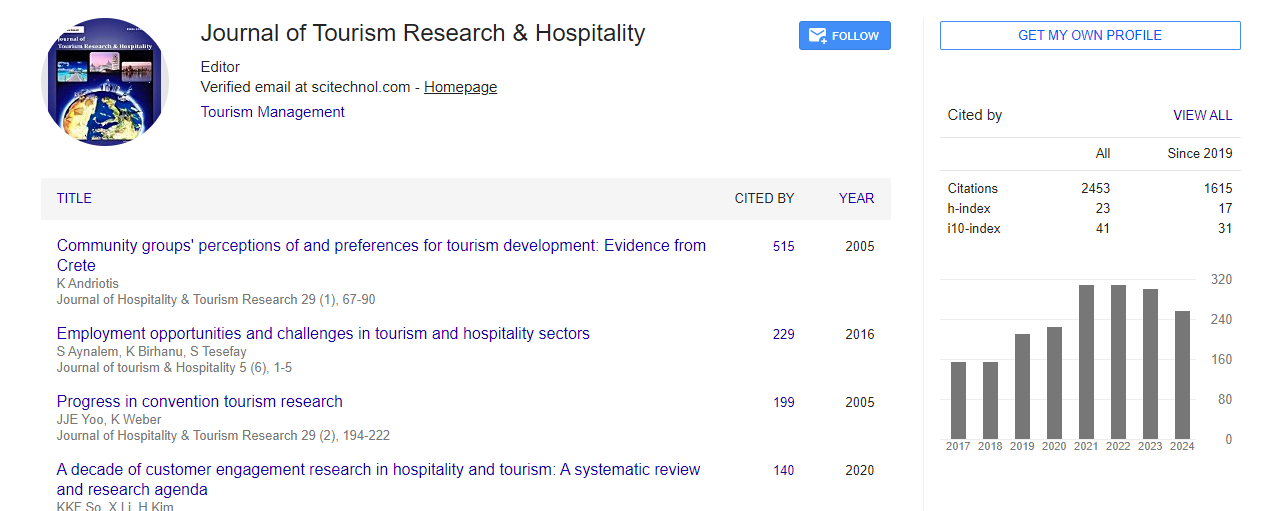Commentary, J Tour Res Hosp Vol: 12 Issue: 3
Tourism Marketing Based on Visual Content
Rachal Perpins*
Department of Tourism, Sport and Hotel Management, Griffith University, Brisbane, Australia
*Corresponding Author: Rachal Perpins
Department of Tourism, Sport and Hotel
Management, Griffith University, Brisbane, Australia;
E-mail: Perpins@ griffithuni.edu.au
Received date: 19 January, 2023, Manuscript No. JTRH-23-87465;
Editor assigned date: 23 January, 2023, PreQC No. JTRH-23-87465 (PQ);
Reviewed date: 06 February, 2023, QC No. JTRH-23-87465;
Revised date: 18 April, 2023, Manuscript No. JTRH-23-87465 (R);
Published date: 25 April, 2023, DOI: 10.4172/2324-8807.10001027
Citation: Perpins R (2023) Tourism Marketing Based on Visual Content. J Tour Res Hosp 12:3.
Description
The usage of public-private sector partnerships in the form of visitor and conference bureaux and a recent tendency toward corporate city marketing are two developments in the tourism organisations in these cities that are highlighted and examined. Although there were some obvious variances, it was discovered tourism marketing objectives were remarkably similar. One of the most effective marketing strategies for promoting market segmentation based on consumer motivation. To better understand the various traits and needs of tourists, the current divides the bed and breakfast market into distinct divisions.
Our findings provide evidence of the type and extent of the impact of television induced tourism on tourism business performance and activity, indicating that the effects were concentrated spatially and temporally, and can help operators allocate resources in developing marketing strategies for tourism business operators on mull. Business operators' perspectives of how marketing influences travel behaviour and major areas of concern for tourism's future development are used to analyse the consequences of marketing. Campaigns focused on prevention seem to be more successful overall than those on recovery. The intention to participate in the campaign marginally increases with the presence of recovery related causes rather than prevention related causes, which is interesting and that further research be done on this tendency.
Create, plan, carry out, and take part in marketplaces and consumer promotions for the travel industry, marketplaces for meetings and conventions, media tours, and industry familiarisation trips. The term "tourist marketing" refers to all of the different marketing tactics employed by companies in the travel and tourism sector. Hotels and other lodging options, as well as transportation companies like airlines and car rental agencies, dining establishments, entertainment venues, travel agencies, and tour operators, are just a few examples. The usage of public-private sector partnerships in the form of visitor and conference bureaux and a recent tendency toward corporate city marketing are two developments in the tourism marketing organisations in these cities that are highlighted and examined. Although there were some obvious variances, it was discovered that the five cities' tourism marketing objectives were remarkably similar.
Theoretically, we may support the sense of community in an online community by pointing to factors like shared interests, a particular language, and member interaction. Studies linking social media to the idea of imagined communities and a sense of belonging do not yet exist. Similar to the idea of the imagined community, customers are engaged and given a sense of belonging when they are a part of a group in the real or virtual world. This allows them to interact directly with the location brand even though they have never met. Utilizing modern technologies enables businesses to interact directly with customers.
The profession of medical tourism relies on effectively educating prospective patients about procedure alternatives, medical facilities, travel arrangements, tourism opportunities, and destination nations. Numerous marketing tools, including flyers, pamphlets, and websites, are used to promote medical tourism. However, nothing is known about the use, nature, and reception of these promotional items. So it makes sense that patients from affluent countries who use the medical tourism sector to travel to developing countries for medical care frequently cite the potential for cost savings as a major driver.
 Spanish
Spanish  Chinese
Chinese  Russian
Russian  German
German  French
French  Japanese
Japanese  Portuguese
Portuguese  Hindi
Hindi 

